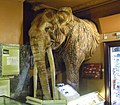Museum of Barnstaple and North Devon
 Museum of Barnstaple and North Devon in 2018 | |
| Established | 1888 |
|---|---|
| Location | Barnstaple, Devon |
| Coordinates | 51°04′40″N 4°03′32″W / 51.07787°N 4.05895°W |
| Website | www |
Museum of Barnstaple and North Devon is a local museum covering the history and culture of the
Design


The structure was built in 1872 for William Thorne, but sold to the Barnstaple Bridge Trust in 1876 who then sold it to William Frederick Rock. Constructed in red brick with dressings of stone and terracotta, the hipped and slated roof has a flat central section which is set with ornamental iron railings together with 5 red brick chimneys with stone caps. The building is square and is built round an internal courtyard with on the right on the building's North side a small service wing which may actually be a former coach-house with a walled courtyard behind.[1]
Inside is a fine wooden staircase in the Jacobean style with twisted balusters and large carved newels with a Gothic stone fireplace in the entrance hall. Behind the building on the river front there is a small garden enclosed by iron railings having spearhead uprights and standards; these railings form part of the listed status for the property. The gate piers and gates with the bases of dolphin lamp posts adjacent to the building are separately listed.[1]
History
The museum was founded as the North Devon Athenæum in 1888 by William Frederick Rock, who intended it to serve as a replacement for the Barnstaple Literary and Scientific Institute he had created in 1845. In addition to functioning as a library and museum, the building served as an informal records office for Barnstaple. An innovation unusual at that time was that men and women shared the reading rooms as Rock believed that separate facilities would encourage women to gossip rather than read. The Librarian lived in the building, a requirement that lasted until the 1930s.[2]
The Devon County Library Service occupied the main floor from 1956, relocating from much smaller premises in the Bridge Buildings across the road. In 1988 the library collection was moved to the specially built North Devon Library and Record Office. The museum collection remained, and was loaned to the Museum of Barnstaple and North Devon, which took over the space.[2]
The Collection
The museum's collections and displays cover the natural and human history of North Devon. Galleries include the Tarka Gallery, the Story of North Devon, the Regimental Collections of the Royal Devon Yeomanry and the Royal 1st Devon Yeomanry,[3] furniture by Shapland & Petter and a collection of 17th century pewter and ceramics from the area[4][5] including Art Pottery by Brannam Pottery, William Leonard Baron and Alexander Lauder.[6] Also on display is a full-size recreation of the front half of the Barnstaple Elephant (Palaeoloxodon antiquus), a rare straight-tusked elephant which became extinct in the UK around 115,000 years ago and the fossil of which was excavated in Barnstaple in February 1844. On display in the prehistory gallery are some tusk and bone fragments while whole teeth were taken to the Natural History Museum in London.[7]
The museum was among ten candidates shortlisted for the £100,000 Gulbenkian Prize for Museum of the Year in 2005 for its work investigating the history of Shapland & Petter, a Barnstaple manufacturing company.[8] In November 2017 the museum was targeted by thieves who broke into the museum and smashed display cabinets, making off with two limited edition Royal Mint collections of gold coins, thought to be worth around £15,000.[9][10]
The museum includes a Gift Shop, Tearoom, Tourist Information Centre and Visitor Reception.[4]
In May 2018 the museum closed so that an extension could be built.[11] It reopened in October 2019, but the Grand Opening in April 2020 has been delayed due to the COVID pandemic.[12]
Gallery
-
The Museum of Barnstaple and North Devon
-
Full-size recreation of The Barnstaple Elephant
-
The Ceramics Gallery
-
The Prehistory Gallery
-
The Exhibition Gallery
-
The Tarka Trail
-
The Victorian Gallery
-
The Museum Shop
References
- ^ a b c "Museum of North Devon including Garden Railings adjacent to River Front". English Heritage. Retrieved 11 June 2018.
- ^ a b "History". North Devon Athenæum. Retrieved 11 June 2018.
- ^ "Royal Devon Yeomanry". Ogilby Trust. Retrieved 11 June 2018.
- ^ a b "Museum of Barnstaple and North Devon". Devon County Council. Retrieved 11 June 2018.
- ^ "Museum of Barnstaple and North Devon". Devon Museums website. Retrieved 11 June 2018.
- ^ "Museum of Barnstaple and North Devon". Culture 24. Retrieved 11 June 2018.
- ^ "The Barnstaple Elephant". Visit North Devon & Exmoor. Retrieved 11 June 2018.
- ^ "History project nominated for arts prize". BBC Devon Community. Retrieved 11 June 2018.
- ^ "Rare golden coins taken during 'smash and grab' break-in at Barnstaple museum". North Devon Gazette. 27 November 2017. Retrieved 11 June 2018.
- North Devon Council. 28 November 2017. Retrieved 11 June 2018.
- ^ "Barnstaple's museum to close as extension project nears". North Devon Gazette. 27 April 2018. Retrieved 5 August 2018.
- ^ Gussin, Tony (21 October 2019). "First look inside Barnstaple museum's new Long Bridge Wing". North Devon Gazette. Retrieved 16 February 2021.
External links
![]() Media related to Museum of Barnstaple and North Devon at Wikimedia Commons
Media related to Museum of Barnstaple and North Devon at Wikimedia Commons









